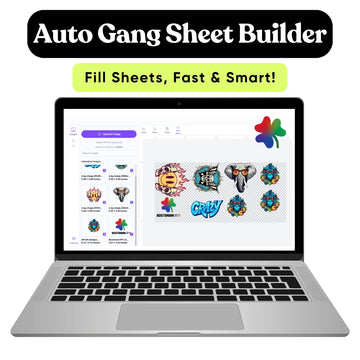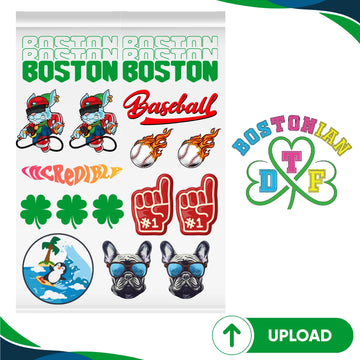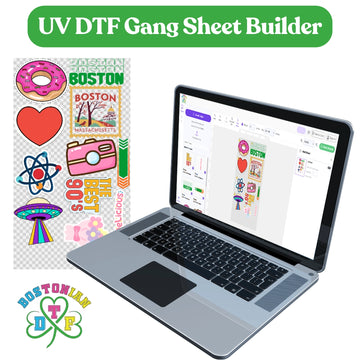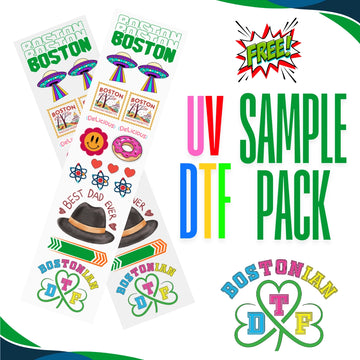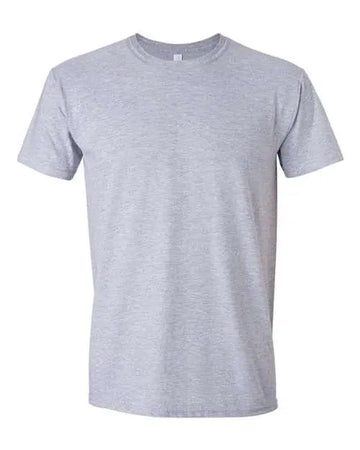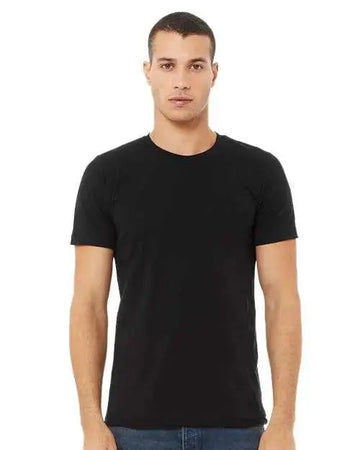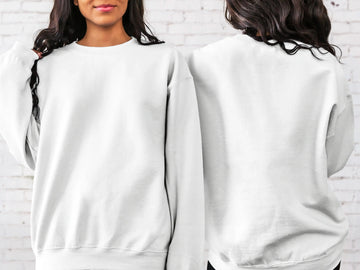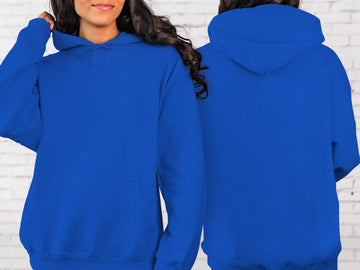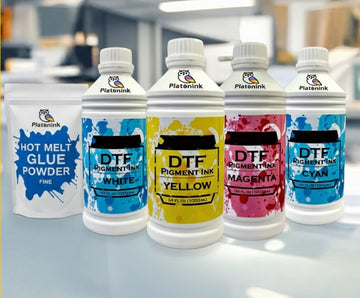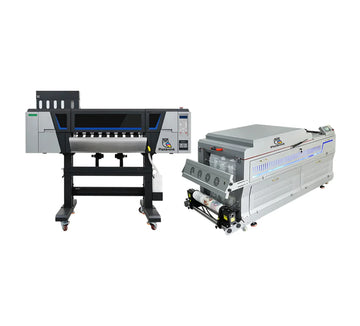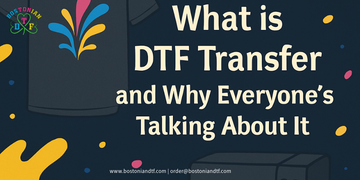With screen printing, DTG, sublimation, vinyl, and now DTF printing in the mix, it’s easy to feel a little overwhelmed. But if you’ve heard whispers (or loud shouts) about DTF, a new printing technique, you’re asking yourself, “What is DTF transfer, and should I care?” The short answer is yes, you absolutely should.
What This DTF Printing Guide Covers
This guide will walk you through what DTF transfer is, the DTF printing process, how it works, what makes it different from other methods, and why people everywhere, from garage startups to pro print shops, are calling it a total game-changer.
Why DTF Transfers Deliver Superior Results
One of the key components of DTF printing is the adhesive layer, which creates a strong bond between the DTF powder and fabric and sublimation ink, preventing issues like cracking or peeling of the transferred design. Additionally, DTF transfers are known for their superior color vibrancy compared to traditional methods like heat transfer paper and sublimation, making them ideal for a wide range of materials.
Introduction to DTF Printing
DTF printing, also known as direct to film printing, is a revolutionary technique that has taken the custom printing industry by storm. This innovative method involves printing designs directly onto a special film, which is then transferred to the desired surface using a heat press machine. The result? High-quality prints with vibrant colors and excellent wash resistance.
Why Choose DTF Printing?
Whether you’re a business looking to create custom garments or an individual wanting to personalize accessories and promotional products using a DTF printer, DTF printing offers a cost-effective and user-friendly solution. With its ability to produce detailed designs and its compatibility with various fabrics, DTF printing is quickly becoming a favorite in the printing industry.
What Does DTF Mean?
DTF stands for Direct-to-Film printing. And yes, it’s exactly what it sounds like. Instead of printing directly onto a t-shirt like with DTG, you first print the design using a DTF printer onto a special film, apply a bit of magic (a.k.a. hot melt powder), and then heat press it onto your fabric. This method of heat transfer results in a soft, vibrant, and durable print that looks like it took hours to make, but didn’t.
The Power of DTF for Custom Fabric Printing
So, if you’re still wondering, what is DTF transfer? It’s simply one of the most versatile and beginner-friendly ways to create long-lasting custom prints on fabric. A crucial component in the DTF process is the DTF powder, a specialty blend that enhances the durability and quality of the transfer by ensuring proper adhesion during heat application.
Equipment Needed for DTF Printing
To get started with DTF printing, you’ll need a few essential pieces of equipment. First and foremost, a DTF printer is a must. This specialized desktop inkjet printer is designed specifically for DTF printing, ensuring that your designs are printed with precision and clarity. Next, you’ll need a heat press machine, which is used to transfer the printed design onto your desired surface.
DTF film is another crucial component; this special film works seamlessly with DTF printers to hold your design until it’s ready to be transferred. Additionally, you’ll need DTF powder, a hot melt adhesive powder that bonds the printed design to the surface. Finally, a curing oven is used to cure the powder, creating a durable, long-lasting finish. With these tools in hand, you’re ready to dive into the world of DTF printing.
How DTF Printing Works (Step by Step, No Tech Degree Needed)
You don’t have to be a print expert to understand how this process works. It is a relatively simple process with just a few simple and easy-to-do steps. Here’s the play-by-play of how DTF printing actually works:
2.4 Printing and Powdering
The first step involves printing your design onto a special film using a DTF printer. After printing, the film is coated with a DTF powder, which adheres to the printed areas. The curing process is crucial at this stage to ensure the powder properly bonds with the ink, minimizing exposure risks and ensuring safety from dust and fumes.
2.5 Heat Pressing
Once the powder has been applied and cured, the next step is to transfer the design onto the fabric using a heat press machine. To avoid direct contact with the transfer film and prevent potential damage, you can use the 'no contact mode' on the heat press. This mode enhances the overall quality of the print by ensuring the heat press does not directly touch the film.
1. Design Time
First, you create your design digitally, ensuring that you use CMYK colors to achieve vibrant prints. This could be done using several easy-to-use tools. Some options include Photoshop, Illustrator, Canva, or whatever you like.
2. Print on Film
You print that design onto a transparent PET film using a DTF printer. A good feature is that the printer lays down white ink as a base so your colors pop, even on dark fabrics.
3. Add Adhesive Powder
Another critical and not-to-be-missed step! While the ink is wet, sprinkle a layer of adhesive powder over the print. This adhesive powder helps bind colored pigments to the surface, enhancing the vibrancy of the prints. This is what makes it stick during the transfer.
4. Melt It
There is one more fact that you need to know while DTF printing. The film goes through a curing step (usually a heat press, hover, or oven) to melt the adhesive powder just enough that it’s ready to stick.
5. Heat Press It
Once all is good to go, it’s show time. Now, place the film on your fabric and press it using a heat press at the right temperature, time, and pressure. Ensuring the correct pressure, time, and temperature is very crucial.
6. Peel and Admire
Let it cool (or peel it hot, depending on your film type), and boom, you have a high-quality print that feels smooth, stretches well, and lasts. Enjoy while it lasts!
Now you know exactly what DTF transfer is in action: It’s fast, reliable, and surprisingly simple.
DTF Film and Powder
DTF film is a crucial component of the DTF printing process. This special film is designed to work with DTF printers and is available in a range of sizes and thicknesses to suit different needs.
Adhesive Powder Creates Lasting Print Bonds
The film is coated with a layer of adhesive, which helps to bond the printed design to the surface. On the other hand, DTF powder is a hot melt adhesive powder that plays a vital role in printing.
Heat Curing Improves Durability and Wash Resistance
After printing your design onto the DTF film, you sprinkle the powder evenly over the wet ink. The film is then cured using a heat press machine or curing oven, which melts the powder and creates a strong, durable bond resistant to washing and wear. This combination of DTF film and powder ensures that your prints are vibrant, detailed, and long-lasting.
DTF Print vs. The Rest: Is It Really Better?
We get this question all the time: How does DTF compare to old-school screen printing, popular DTG printing, and others?
Here’s the real talk:
|
Feature |
DTF Printing |
DTG Printing |
Screen Printing |
|
Fabric Options |
All types |
Cotton only |
Mostly cotton |
|
Setup Time |
Low |
Moderate |
High |
|
Print Durability |
Excellent |
Good |
Excellent |
|
Color Vividness |
Super vibrant |
Great |
Great |
|
Small Run Friendly |
Very! |
Somewhat |
Not really |
|
Feel on Fabric |
Soft, flexible |
Soft |
Sometimes thick |
Better Color and Durability
Compared to other printing methods, traditional methods like heat transfer paper and DTF transfers offer superior color vibrancy and durability, making them a more versatile and practical option across a broader range of materials.
Ideal for Short Runs
So, is DTF better than the others? For many people, yes. Especially if you’re doing small runs, want to print on a wide range of materials, or enjoy a more straightforward process with less mess.
DTF's Printing Advantage
Understanding DTF transfer helps you see why it’s become the preferred choice for custom and apparel printing. This revolutionary printing technique excels in transferring designs onto various substrates and stands out in Direct-To-Fabric processes for larger fabric rolls.
Why Businesses and Entrepreneurs Love DTF Print?
Let’s be honest, every printing method claims to be revolutionary. But DTF has earned its hype, and rightly so. With customization in place, the possibilities are limitless. DTF benefits a printing business by enhancing custom garment production capabilities and improving operational efficiency. Here’s why people are making the switch:
Ideal for Small Businesses
DTF transfers are not just for home crafters and commercial enterprises; they are particularly advantageous for small businesses. These transfers present unique opportunities for customization and creativity, empowering small businesses and the printing industry to enhance their offerings and stand out in the competitive market.
No Fabric Limits
Whether you’re pressing on cotton, polyester, denim, or even canvas bags, DTF’s got your back. You don’t need to worry about switching processes for each material. DTF is just as flexible as it is customizable. Athletic wear is another versatile category for DTF transfers, making it perfect for various types of workout gear and team uniforms.
No Pretreating
DTG printing requires you to pretreat your garments before printing. DTF skips that. Less time, less hassle. This cuts down one more step needed in the traditional DTG.
Color Pop is Real
Thanks to that white ink underbase, designs come out vibrant, even on dark garments. DTF prints are not only seamless and straightforward but also very eye-catching and have an appeal.
Durability Like No Other
Another benefit of DTF is that they are super durable, especially when proper care is taken to avoid excess powder during application. DTF prints are wash-resistant, flexible, and made to last. There will be no cracking or fading. This is the DTF promise for you.
Budget-Friendly
If you're starting out or only printing small batches, DTF is cost-effective and gives you pro-level results without needing to invest in huge setups. It's perfect for startups and DIYers.
Still unsure what the DTF transfer is good for? The answer is: just about everything.
What Can You Use DTF Transfers For?
Honestly? Pretty much anything.
- Custom t-shirts
- Hoodies and sweatshirts
- Kidswear
- Sports jerseys
- Tote bags
- Aprons
- Hats and caps
- Even jeans and jackets
DTF transfers can reproduce intricate designs with remarkable detail, making them perfect for custom printing enthusiasts. These transfers can be applied across multiple products, including various accessories and promotional items.
If it can handle heat, you can press it.
Once you understand what DTF transfer is, your imagination is the only limit.
Do DTF Transfers Work?
Yes, DTF transfers do work! In fact, they offer several benefits over other printing methods. DTF transfers produce high-quality prints with vibrant colors and excellent wash resistance, making them ideal for custom garments and accessories.
Highly Durable and Versatile
They are also highly durable and can withhold repeated washing and wear without fading or cracking. One of the standout features of DTF transfers is their versatility; they can be used on a wide range of surfaces, including cotton, polyester, and blends.
Easy Application
Applying DTF transfers is straightforward. Only a heat press machine or even a household iron is needed to transfer the printed image design onto the surface. With their ease of use and impressive results, DTF transfers are a reliable choice for anyone looking to create custom prints.
Tips to Get the Best Out of Your DTF Transfers
Want your prints looking sharp and lasting long? Keep these in mind:
- Use quality supplies: Not all films, powders, and inks are created equal.
- Follow press settings: Time, temperature, and pressure matter. Don’t eyeball it.
- Let transfers cool before peeling: Unless you’re using hot peel film.
- Store prints flat: Keep them dry and clean until use.
- Incredibly flexible: DTF prints are incredibly flexible and can endure multiple washes without fading or cracking, making them suitable for frequently used items.
Troubleshooting Common Issues
Like any printing method, DTF printing can be prone to certain issues. One common problem is excess powder, which can cause the printed design to appear cloudy or distorted. To avoid this, it’s essential to use the right amount of powder and to apply it evenly to the printed film.
Managing Excess Powder
Another common issue is poor print quality, which can be caused by a range of factors, including low-quality ink or incorrect printer settings. To troubleshoot this issue, try adjusting the printer settings or using high-quality ink for sublimation printing.
Using Quality Materials
Additionally, ensure that your DTF film and powder are of good quality, as subpar materials can affect the final result. With a little practice and patience, you can achieve high-quality DTF transfers that are vibrant, durable, and long-lasting.
Not Ready to Print your DTF?
You don't have to if you’re not ready to print your transfers yet. At Bostonian DTF, you can order custom DTF transfer film prints that are ready to press right out of the package.
Wrapping it Up
If you’re still asking, “What is DTF transfer?” Think of it as the future of custom apparel printing, which is already here and growing fast.
It’s flexible, affordable, and works like a charm on almost anything. With tools and services like Bostonian DTF, even complete beginners can create high-quality designs that stand out. The growing demand for DTF in the textile industry highlights its potential to revolutionize fabric printing.
Ready to try it yourself?
So, whether you’re a clothing brand, side hustler, or just want to press your own merch, DTF print is worth a serious look. Explore our custom transfer options at Bostonian DTF and start creating with confidence.

